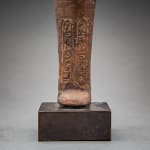Egyptian terracotta ushabti, 600 BCE - 500 BCE
Terracotta
height 21.6 cm
height 8 1/2 in
height 8 1/2 in
PH.0162
Further images
Ushabti were funerary figurines placed in tombs among the grave goods in Ancient Egypt and were intended to act as servant figures that carried out the tasks required of the...
Ushabti were funerary figurines placed in tombs among the grave goods in Ancient Egypt and were intended to act as servant figures that carried out the tasks required of the deceased in the underworld. Very often they carry inscriptions in hieroglyphs, typically concentrated on the lower part of the body.
The practice of using ushabtis originated in the Old Kingdom (c. 2600 to 2100 BC) with the use of life-sized reserve heads made from limestone, which were buried with the mummy.
Most ushabtis were though of a reduced size, and many were produced in multiples; sometimes they were thus numerous as to fill the floor of the chamber around the sarcophagus. Exceptional ushabtis are of larger size and were produced as a one of-a-kind master work. The term shabti applies to these figures prior to the 21st dynasty of Egypt but after the end of the First Intermediate Period, and really only to those figurines inscribed with Chapter Six of the Book of the Dead. The term ushabti became prevalent after the 21st Dynasty and remained in use until Ptolemaic times. Otherwise, the best term by which they might better be defined, although generic, would be funerary figurines.
The ushabtis were not effective because of their artistry but were effective because of the inscriptions they bore, as a result of the Ancient Egyptian belief that anything written down was true, as writing was thought to change wishes and thoughts into actions. Therefore, it was necessary for the owner's name to be inscribed on an ushabti, along with a phrase sending the ushabti into action. Ushabtis were mostly mummiform, but during the Dynasty XVIII reign of Thutmose IV, they began to be fashioned as servants with baskets, sacks, and other agricultural tools, implying that they were intended to farm for the deceased. Early ushabtis were sometimes made from wax, though later figurines were often made of less perishable materials such as stone, terracotta, metal, glass and, most frequently, glazed earthenware (faiance). While ushabtis manufactured for the rich were often miniature works of art, very beautiful in form and colour, the great mass of cheaply made ushabtis were the results of a standardised production, made from single molds with very little detail.
The practice of using ushabtis originated in the Old Kingdom (c. 2600 to 2100 BC) with the use of life-sized reserve heads made from limestone, which were buried with the mummy.
Most ushabtis were though of a reduced size, and many were produced in multiples; sometimes they were thus numerous as to fill the floor of the chamber around the sarcophagus. Exceptional ushabtis are of larger size and were produced as a one of-a-kind master work. The term shabti applies to these figures prior to the 21st dynasty of Egypt but after the end of the First Intermediate Period, and really only to those figurines inscribed with Chapter Six of the Book of the Dead. The term ushabti became prevalent after the 21st Dynasty and remained in use until Ptolemaic times. Otherwise, the best term by which they might better be defined, although generic, would be funerary figurines.
The ushabtis were not effective because of their artistry but were effective because of the inscriptions they bore, as a result of the Ancient Egyptian belief that anything written down was true, as writing was thought to change wishes and thoughts into actions. Therefore, it was necessary for the owner's name to be inscribed on an ushabti, along with a phrase sending the ushabti into action. Ushabtis were mostly mummiform, but during the Dynasty XVIII reign of Thutmose IV, they began to be fashioned as servants with baskets, sacks, and other agricultural tools, implying that they were intended to farm for the deceased. Early ushabtis were sometimes made from wax, though later figurines were often made of less perishable materials such as stone, terracotta, metal, glass and, most frequently, glazed earthenware (faiance). While ushabtis manufactured for the rich were often miniature works of art, very beautiful in form and colour, the great mass of cheaply made ushabtis were the results of a standardised production, made from single molds with very little detail.







